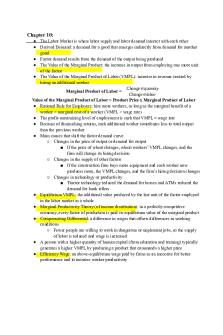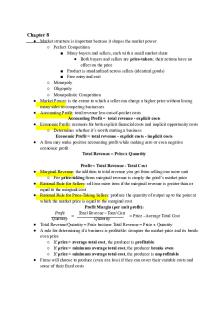Micro Econ Chapter 9 - Notes that I took while reading the textbook and going to class. PDF

| Title | Micro Econ Chapter 9 - Notes that I took while reading the textbook and going to class. |
|---|---|
| Author | tamthoho NA |
| Course | Micro Economics |
| Institution | Georgia State University |
| Pages | 13 |
| File Size | 620 KB |
| File Type | |
| Total Downloads | 69 |
| Total Views | 127 |
Summary
Notes that I took while reading the textbook and going to class....
Description
Chapter 9 Firms in a Competitive Market How Competitive Markets Work
Similar goods and many participants create a highly competitive market where the price and quantity sold are determined by the market conditions rather than by any one firm In competitive markets, buyers can expect to find consistently low prices and wide availability of the good that they want New competitors can easily enter the market and exit the market Price taker: firms that produce goods in competitive markets that have no control over the price set by the market. o It “takes”, accepts the price determined from the overall supply and demand conditions that regulate the market
How Firms Maximize Profits
The information found in the profit column is unavailable until long after the business decisions have been mad. So, in day-to-day operations, the firm needs another way to make production decisions o By examining the marginal impact, a firm can make good day-to-day operational decisions Profit-maximizing rule: states that profit maximization occurs when a firm expands
output until marginal revenue is equal to marginal cost, MR = MC o According to this rule, production should stop at the point which profit opportunities no longer exist To understand cost structure, a firm focuses on marginal cost, same is true for revenue If MR > MC, then cost of producing additional units adds more to revenue than to costs, this means production should continue If MR < MC, then the cost of producing additional units is more than additional revenue those units bring in; further production is not profitable If MR = MC, then this is the exact level of production at which no further profitable opportunities exist and losses have not yet occurred. This is the optimal point at which to stop production Deciding How Much to Produce in a Competitive Market
A firm in a highly competitive market is a price taker; it has no control over the price set by the market; must charge the price that is determined from the overall supply and demand conditions that regulate that market
Profit = Price – ATC [along the dashed line at quantity Q]) x Q Firm in the Short Run
When revenue is insufficient to cover cost, the firm suffers a loss—at which point it must decide whether to operate or temporarily shut down o Example: retail stores often close by 9p.m because operating overnight would not generate enough revenue to cover costs of remaining open If a firm would lose less by shutting down than by staying open, it should shut down. Once variable costs are covered, it will choose to remain open, and extra money goes towards paying fixed costs; if it cannot cover variable costs, it should shut down o As long as MR curve of the firm is greater than the minimum point on the AVC (average variable cost) curve, the firm will choose to operate
o If the MR curve falls below the AVC curve, the red-shaded area—the firm should shut down
Firm’s Long-Run Supply Curve In the long-run, a firm’s output decision is directly tied to profits Since the firm is flexible in the long run, all costs are variable The firm’s long-run supply curve exists only when the firm expects to cover its total costs of production In the long run, a firm that expects price to exceed ATC will continue to operate, since the conditions for making a profit seem favorable If a firm does not expect price to exceed ATC, it should cut its losses and exit the industry
Sunk Costs Sunk costs: costs that have been incurred as a result of past decisions o Example: the decision to build a new sports stadium, as years pass by they are replaced with better innovations and features o The additional revenue makes the new stadiums financially attractive even though the old stadiums were still structurally sound o When the extra benefit of a new stadium is large enough to pay for the cost of imploding the old stadium and constructing a new one, a city will do just that This occurs because of increased ticket sales, higher tax revenues, and a more enjoyable experience for fans
What the Supply Curve Looks Like in Perfectly Competitive Markets Short-Run Market Supply Curve Short-run market supply curve = individual firm supply curves since they are equal to their marginal cost curve...
Similar Free PDFs

Textbook Notes- chapter 9
- 4 Pages

Chem 9 - textbook reading
- 12 Pages

ECON 1001 Textbook Notes
- 43 Pages

Chapter 9 - class notes
- 7 Pages

Chapter 9 Class Notes
- 2 Pages

Micro Chp. 3 class notes 9 13
- 5 Pages

Textbook Notes (Chapter 4) 9
- 3 Pages
Popular Institutions
- Tinajero National High School - Annex
- Politeknik Caltex Riau
- Yokohama City University
- SGT University
- University of Al-Qadisiyah
- Divine Word College of Vigan
- Techniek College Rotterdam
- Universidade de Santiago
- Universiti Teknologi MARA Cawangan Johor Kampus Pasir Gudang
- Poltekkes Kemenkes Yogyakarta
- Baguio City National High School
- Colegio san marcos
- preparatoria uno
- Centro de Bachillerato Tecnológico Industrial y de Servicios No. 107
- Dalian Maritime University
- Quang Trung Secondary School
- Colegio Tecnológico en Informática
- Corporación Regional de Educación Superior
- Grupo CEDVA
- Dar Al Uloom University
- Centro de Estudios Preuniversitarios de la Universidad Nacional de Ingeniería
- 上智大学
- Aakash International School, Nuna Majara
- San Felipe Neri Catholic School
- Kang Chiao International School - New Taipei City
- Misamis Occidental National High School
- Institución Educativa Escuela Normal Juan Ladrilleros
- Kolehiyo ng Pantukan
- Batanes State College
- Instituto Continental
- Sekolah Menengah Kejuruan Kesehatan Kaltara (Tarakan)
- Colegio de La Inmaculada Concepcion - Cebu








